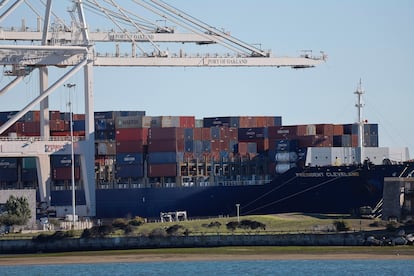
In anticipation that Donald Trump’s threat to impose tariffs on Mexico, Canada and China will be carried out within 24 hours of taking office, U.S. importers have been rushing to stock up. Ports such as Los Angeles and Long Beach, which together receive a third of all containers arriving in the U.S., registered record levels of activity in October, even before the election, when the Republican candidate was loudly saying that tariff is “the most beautiful word in the dictionary” and threatening a 60% levy on Chinese-made products. Freight volume from this country increased by almost 13% in October compared with the same month last year; in September, by comparison, year-on-year growth was 2.4%.
China remains the world’s leading exporter of goods, and the United States is its biggest customer. Last year, it bought some $430 billion from the Asian giant, most of it in computer and electronic products. But clothing and footwear will not be cheap in the U.S. either if the announced tariffs go through. The footwear and accessories firm Steve Madden plans to cut its production in China by between 40% and 45% and move it to neighbouring countries such as Vietnam. Walmart, the country’s largest employer, has warned about the impact on prices, as have executives at almost 200 companies in the S&P 1500 Composite index since early September, almost twice as many as on the eve of the 2020 elections.
The president-elect’s cheerfully self-inflicted shot in the foot represented by the use of tariffs for trade and foreign policy purposes has been summed up in a report by the Pearson Institute for International Economics (PIIE), titled What Populists Don’t Understand about Tariffs (But Economists Do). The tariffs Trump is now proposing would apply to more than eight times the imports of his last round (about $3.1 trillion in 2023 data), implying a much greater impact on prices, it warns, underscoring that far from aiding U.S. employment and production, tariffs will do harm.
Tariffs are also a cause for concern for small and medium-sized businesses. In the Flushing neighborhood of Queens, in New York City, the Liu brothers are wondering about the viability of their fashion and accessories store if the additional 10% fee on imports from China that Trump announced last Monday is implemented. Their business renews stock twice a year, and partly four times a year, and shares the cost of imports with independent stores in San Francisco and Philadelphia, but the system would collapse with additional tariffs.
“If we don’t raise prices, we will lose a lot of money. And our prices were already a bit high for the neighborhood, which is full of industrial and mass-produced goods, and therefore cheaper. Without customers who are willing to pay 30% more for a sweater or a bag, which according to our calculations will be the minimum amount we will have to raise, we will have to close,” they explain.
Three blocks away, the manager of a giant Chinese supermarket who asks not to be identified by name shrugs when asked about the impact. “Ninety-five percent of the products are imported from China, the rest from other Asian countries, and a very small part is produced here, such as some dairy products, or else it comes from Mexico and Canada, such as a few vegetables. We will have to raise prices, because there is no local substitute production, except for a very small number of products. Most vegetables and frozen fish come from China,” he explains.
Local shops
Local businesses like the Lius’ independent store and the supermarket, which are also subject to the perishable nature of some of their products, do not have of wholesalers who have accelerated their early orders in order to stock up on as much as they can ahead of January 20. “We have bought $50,000 worth in one go, including all the advances for the next seasons, but we cannot go beyond the calendar and the production of the designers. We also have no alternative, because they are young designers with very limited production, hence the greater impact on the price,” explain the Liu brothers.
When Trump began his trade war against China in 2018, American companies rushed to accelerate early imports, just as they are doing now. As a result, the trade deficit with China widened in 2018 before declining in 2019. Although China’s share of U.S. imports was reduced to about 14% in 2023 from 22% in 2017, the tariff hike did little to curb the U.S.’s overall global trade deficit or China’s overall trade surplus.
For some analysts, the tariff threat has an advantage: contributing to a “strong dollar policy.” A note to clients from the Macquarie Group on the eve of the elections noted that Trump pursues policies (higher tariffs, less immigration, lower taxes) that are inflationary, which could push the Federal Reserve to be tougher in the 2025-26 horizon. “Trump’s policies are strong dollar policies.”
As with his plans for mass deportation of immigrants, it remains to be seen whether the announced tariffs will actually be implemented, if Trump’s first term in office is anything to go by. “Donald Trump was willing to tweet out tariff threats, usually in the evening, after watching Fox News, and those tweets typically didn’t come to much of anything,” Scott Lincicome, a trade expert at the libertarian Cato Institute, recalled recently in statements to public radio NPR.
Sign up for our weekly newsletter to get more English-language news coverage from EL PAÍS USA Edition




